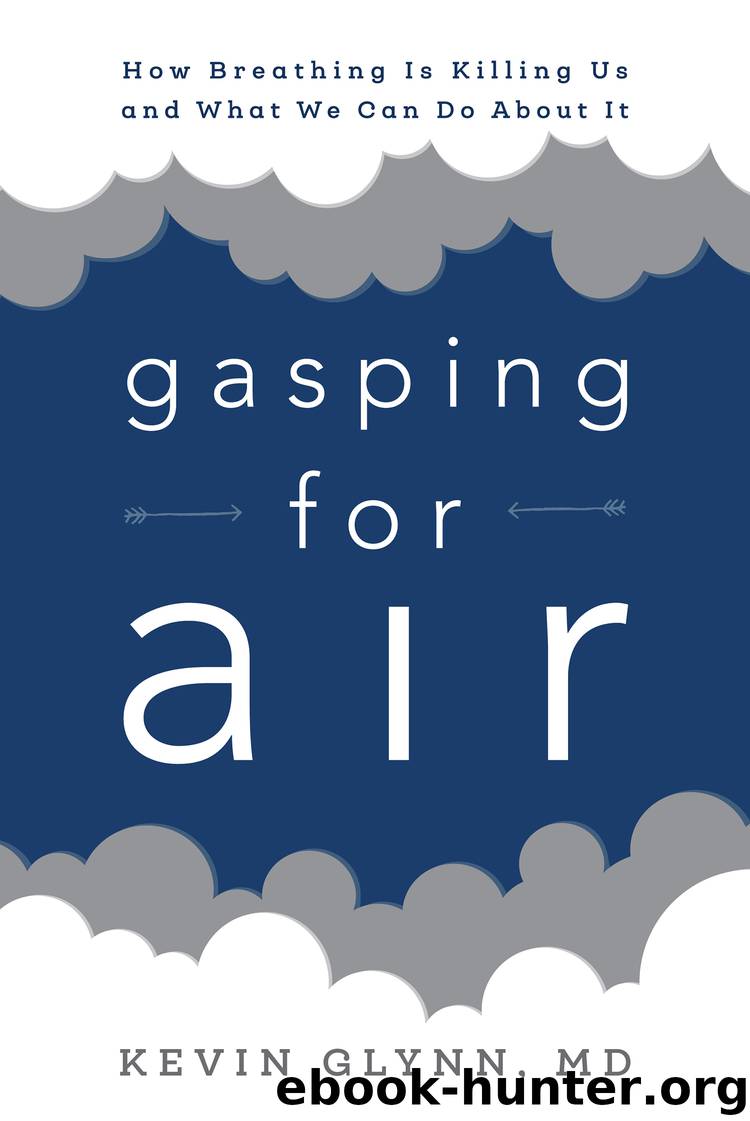Gasping for Air by Kevin Glynn MD

Author:Kevin Glynn MD [Glynn;MD, Kevin]
Language: eng
Format: epub
Publisher: Rowman & Littlefield Publishers
Published: 2017-07-12T04:00:00+00:00
III
Vulnerable Breathing
14
Panting for Air
“The face is pale, the expression anxious, speech is impossible, and in spite of the most strenuous inspiratory efforts, very little air enters the lungs.”
—William Osler1
“It’s strange that words are so inadequate. Yet, like the asthmatic struggling for breath, so the lover must struggle for words.”
—T. S. Eliot2
Polluted air, toxins, infections, and carcinogens are external threats to breathing. They arise from the outside environment. But many forms of chronic lung disease have an internal component as well. Asthma belongs in this category. Only 10 percent of the population has asthmatic tendencies. Thus, something must be deficient in the lungs of certain people to make them vulnerable to asthma.
Mike worked as a respiratory therapist, and I was his medical director. He had asthma. One night at eleven o’clock, Mike arrived at the emergency department, panting for air. He had been fighting an asthma attack for two days and that evening deteriorated. His fiancée immediately drove him to the hospital and summoned me.
Mike was so breathless he couldn’t speak. Drops of perspiration collected in his hair and trickled down his neck. His skin was pale, his tongue dry, his pulse rapid. Neck muscles bulged as he strained to exhale. Mike was on the brink of respiratory arrest and needed help right now.
Asthma is chronic reversible inflammation of the bronchi, the tiny tubules that transport air in and out of the lungs. During an asthma attack, these airways constrict, their walls swell, and mucus accumulates, obstructing flow of air. Asthma attacks cause cough, wheezing, and difficulty breathing. However, when an attack subsides, symptoms disappear and pulmonary function may become normal. Most asthma begins in childhood, and attacks recur throughout life in the majority of sufferers. A few unlucky patients develop permanent irreversible obstruction and evolve into COPD.
Asthma is formidable. It results in more than 500,000 hospital admissions every year in the United States. Ten percent of hospitalized asthmatics require treatment in an intensive care unit, and one-fifth of these need mechanical ventilation to survive. Asthma can also be lethal. It causes 3,000 deaths each year in the United States, mostly among adults, and an estimated 250,000 worldwide, especially in developing countries.
Earlier I described my first emergency room visit as a ten-year-old battling the disease. Two of my grown children and two grandchildren also have asthma. Improved treatment has enabled them to lead normal lives with minimal restrictions. Inhaled bronchodilators and steroids have warded off disability, but when hit by an upper respiratory infection, they can overnight choke up enough to force a visit to the emergency department. Fortunately, I am the last Glynn to have required hospital admission for asthma, and that was sixty years ago. But many asthmatics fare worse.
Asthma is an ancient disease. The word comes from a Greek verb meaning “to pant or to experience difficulty breathing.” Chinese manuscripts from 2500 BCE mentioned it, as did Egyptian scrolls written several hundred years later. Hippocrates was the first to define it as a medical problem, and many famous medical writers over the centuries discussed its manifestations and treatment.
Download
This site does not store any files on its server. We only index and link to content provided by other sites. Please contact the content providers to delete copyright contents if any and email us, we'll remove relevant links or contents immediately.
| Administration & Medicine Economics | Allied Health Professions |
| Basic Sciences | Dentistry |
| History | Medical Informatics |
| Medicine | Nursing |
| Pharmacology | Psychology |
| Research | Veterinary Medicine |
Good by S. Walden(3488)
The Social Psychology of Inequality by Unknown(2940)
0041152001443424520 .pdf by Unknown(2784)
The Checklist Manifesto by Atul Gawande(2779)
The Meaning of the Library by unknow(2505)
Guns, Germs and Steel by Diamond Jared(2303)
Borders by unknow(2229)
23:27 by H. L. Roberts(2197)
And the Band Played On by Randy Shilts(2129)
Get What's Yours for Medicare: Maximize Your Coverage, Minimize Your Costs by Philip Moeller(2098)
Being Mortal: Medicine and What Matters in the End by Atul Gawande(2085)
A Leg to Stand On by Oliver Sacks(2005)
The Hot Zone by Richard Preston(1983)
The Valachi Papers by Peter Maas(1814)
The Laws of Medicine by Siddhartha Mukherjee(1755)
The Andromeda Strain by Michael Crichton(1696)
The Obesity Epidemic by Robyn Toomath(1646)
Pharmacy Practice and The Law by Richard Abood(1543)
Autism's False Prophets by Paul A. Offit(1496)
